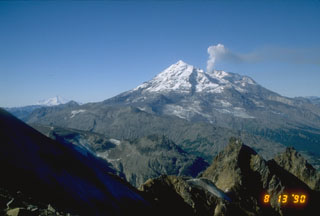Report on Redoubt (United States) — November 1990
Bulletin of the Global Volcanism Network, vol. 15, no. 11 (November 1990)
Managing Editor: Lindsay McClelland.
Redoubt (United States) Small steam and ash emissions; slowly declining seismicity
Please cite this report as:
Global Volcanism Program, 1990. Report on Redoubt (United States) (McClelland, L., ed.). Bulletin of the Global Volcanism Network, 15:11. Smithsonian Institution. https://doi.org/10.5479/si.GVP.BGVN199011-313030
Redoubt
United States
60.485°N, 152.742°W; summit elev. 3108 m
All times are local (unless otherwise noted)
The following report, from the AVO staff, covers the period 12 November-14 December. "No significant change in activity has been observed at Redoubt since the last report. Steam and ash emissions from the lava dome, detected seismically, continue at a rate of several/day. No reports of ash deposition on the flanks of the volcano have been received, suggesting that these phreatic events continue to be relatively minor. However, decreasing daylight hours and infrequent overflights have limited observations.
"Overall seismicity at Redoubt is at a low level, and continues to decline slowly. The automatic event detection system triggered on 246 events between 12 November and 14 December (about 8 events/day). These are mostly shallow B-type (low-frequency) events in the vicinity of the lava dome, although a few A-type (high-frequency) events daily continue at 4-10 km depth beneath the volcano. Shallow tremor associated with steam and ash emissions continues to be recorded several times/day, with typical durations ranging from 5 to 20 minutes; occasionally, periods of nearly continuous tremor may last several hours. These longer periods appear, in some cases, to be 'triggered' by one of the steam and ash events.
"AVO field crews observed the partly snow-covered lava dome on 14 December, and reported that it continued to steam vigorously, as did some of the pyroclastic flow deposits at the N base of the volcano. A minor amount of ash mantled the dome's surface. No significant ash deposits were seen elsewhere in the crater or on the volcano's flanks.
"COSPEC measurements have not been made at Redoubt since 8 November. Insufficient ultraviolet light precludes operation of the COSPEC until sometime in February."
Geological Summary. Redoubt is a glacier-covered stratovolcano with a breached summit crater in Lake Clark National Park about 170 km SW of Anchorage. Next to Mount Spurr, Redoubt has been the most active Holocene volcano in the upper Cook Inlet. The volcano was constructed beginning about 890,000 years ago over Mesozoic granitic rocks of the Alaska-Aleutian Range batholith. Collapse of the summit 13,000-10,500 years ago produced a major debris avalanche that reached Cook Inlet. Holocene activity has included the emplacement of a large debris avalanche and clay-rich lahars that dammed Lake Crescent on the south side and reached Cook Inlet about 3,500 years ago. Eruptions during the past few centuries have affected only the Drift River drainage on the north. Historical eruptions have originated from a vent at the north end of the 1.8-km-wide breached summit crater. The 1989-90 eruption had severe economic impact on the Cook Inlet region and affected air traffic far beyond the volcano.
Information Contacts: AVO Staff.

